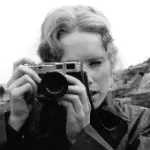If we were in the Arctic and saw a flower growing from a crevice in a rock, how would we react? This idea reminds me of the book of poetry "My Solitude is a Garden" by Adonis, the Syrian poet who has experienced much suffering.
Humans are a species that crave communication, and most of us loathe solitude. There have been many successful films that depict stories of loneliness throughout the history of cinema, and I often wonder why this is. The answer could be various: stories about loneliness are usually performed by talented actors, and we derive pleasure from watching their performances. Additionally, the theme of loneliness allows us to explore how a person copes with nature, animals, and their inner self in an environment far removed from human civilization. It shows us how far we can retain our humanity when we remove the masks of ordinary social life and abandon the moral pressures of society. As an audience, we are presented with a space for contemplation-- if we were in the protagonist's shoes, how would we react?
Such films have several classics like "Into the Wild," "Buried," "Cast Away," and the latest one "Fall." The first one depicts the main character actively choosing to leave human society, while the others depict the main character being passively forced into an extremely harsh survival environment. Today, I want to tell the story of another protagonist who is passively caught in a desperate situation -- "Arctic."
The film, directed by Brazilian director Joe Penna (who is also one of the scriptwriters) and starring Danish actor Mads Mikkelsen, was a finalist in the official selection of the 2018 Cannes Film Festival and was nominated for a Golden Camera Award (given to a director’s first or second feature). “Arctic” tells the story of a Danish man (played by Mads Mikkelsen) who becomes stranded in the Arctic while trying to survive and seek rescue. The film was shot in Iceland, which provided a suitable production country and polar landscape for the movie.
With only one actor and almost no lines, the film tells a story that audiences worldwide can understand without subtitles. The film's narrative style is restrained yet effective, and its cinematography, sound, and performances are excellent. The makeup and special effects are also very realistic, depicting the main character's missing toe, a polar bear attack, a plane crash, and more. However, I feel that the music appears too frequently and could be reduced to improve the overall viewing experience. Nevertheless, it is a quality movie.

The beginning of the film is efficient; it does not explain who the main character is, his background, or how he experienced a plane crash and survived. The audience only sees a crashed plane in the polar regions and a lone man asking for help at the beginning. It is simple and direct. He lives in the wreckage of the plane to keep his body temperature at night, draws big SOS marks on the snow, sustains his life by fishing, relies on the alert sound of his watch, and maintains a routine. He uses the signal machine to search for rescue aircraft. Day after day, low temperature and time are his enemies, which test his will and endurance. The man finally waited for a helicopter to rescue him, but the plane crashed, and of the two in the crew, the man died, and the woman was also dying. The man took care of her wounds and pulled her back to his cabin to take care of her. He was eager to communicate with humans, but due to the loss of consciousness and the language barrier, he was again disappointed. The good thing is he acquired some survival equipment. However, he realized that the survival space is squeezed, and the risk of infection of the woman's wound makes the cabin unsuitable for a longer stay. The man decided to use his newfound map and equipment to take her on foot to the nearest rescue station. Now we can imagine ourselves in the man's experience.
From almost being rescued to taking care of a person who tried to rescue him, only to now risk dragging the woman on foot in this polar environment, the man has to go through moments of self-doubt during the walk: Is what I am doing worth it? If he stays in the cabin, he simply does not need to take the risk and can wait for the next rescue without worrying. But the bad conditions on the road, blizzards, blocked slopes, and polar bear attacks, each deepen his torture of conscience.

Then, the man ran out of supplies and exhausted, the woman could not hold his hand tightly and he had to give her up. Even though he knew that she was still alive, reason told him that the only way to survive was to leave her alone. We can say that his judgment at this point is cold but clear. His judgment tells him that a person should be saved rather than left to die. He did so, but the story did not end there. Accompanied by the music of the cello, our main character saw a flower blooming in rock crevices, which represents tenacious life. Self-doubt returned, but he continued. Immediately after, he fell into an ice cave, and his foot was stuck by the rocks, unable to break away. The man looked up at the cave and underwent the biggest psychological transformation: is this the end of my life? In this case, the real experience of loneliness and helplessness after the inability to move was so strong that he completely understood the woman's experience, and we also felt the despair that did not need to be expressed in words. The man at this point pulled himself together again, with the last of his willpower, pulled out his legs, and escaped from the cave.

Upon his return to the protagonist, he discovered that she was already conscious, prompting him to utter "hello," "you're not alone," and "I apologize" repeatedly. These words held significance not only for the protagonist but also for the man himself. I was touched by Mads Mikkelsen's acting skills in here. The heroine's attitude at this point has also changed, her expression was obviously richer. The unconscious woman beside him is his past, present, and future, she is his mirror. From now on, they have fused into one. And then, his behavior afterward is not difficult for us to understand. He stops the pain with frozen numbness, drags his broken leg and crutches, and continues to take the heroine forward, regardless of his life and death, together facing the unknown fate. At that moment, the loneliness of human beings disappears. Even after the misconception that the rescue had left, the man still holds and comforts the woman, saying "it's okay, I'm with you." The two humans together hold hands and lay down on the snow, staring at the camera and waiting for their unknown fates. The movie has already conveyed its emotional message to the audience and succeeded at this point.


After the movie, I leaned over the heater and opened the window to smoke a cigarette. The chill of the late winter night made me feel the difference in temperature in my body. I thought about which environment is harsher: our society or the Arctic. Our society is a jungle with many hunters with shotguns, and many times human beings choose to sacrifice others for their own benefit. We give up or even harm others for the sake of self-profit, and bestiality often overcomes humanity. On the other hand, Arctic conveys the idea that in extreme environments, in addition to the nature of self-help and survival intention, we humans can also act for the sake of others. This light of humanity is what we should always hold on to, even in a future society led by AI where there are no more movies.
I closed my window and had an idea to go to Iceland, before the Arctic.















































View replies 0
View replies 0
View replies 0
View replies 0
View replies 0
View replies 0
View replies 0